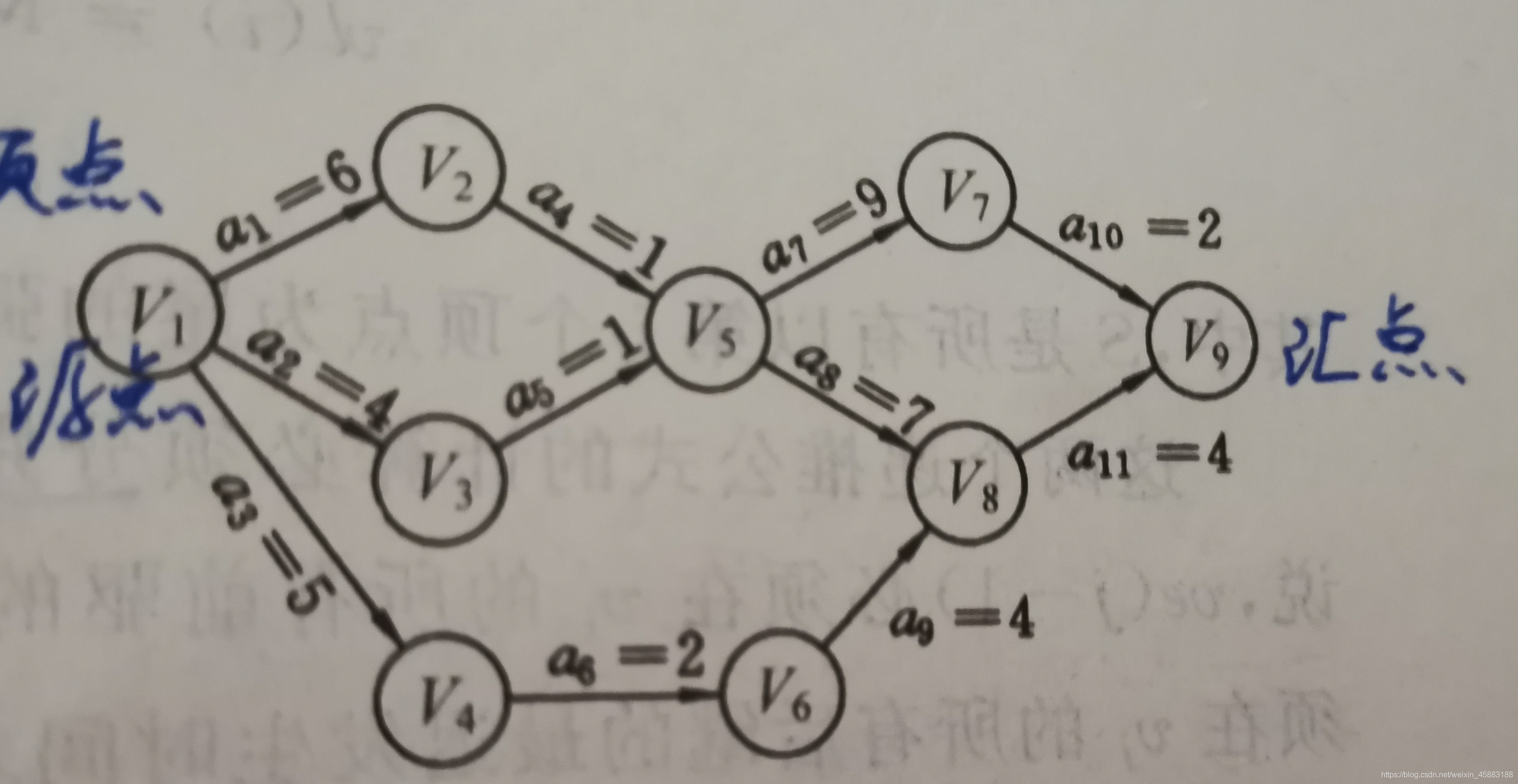C語言實現 尋找AOE-網的關鍵路徑
2020-08-08 20:41:28
1、在AOE-網中,頂點表示事件,邊表示活動
2、儲存形式:鄰接表
3、實現關鍵:尋找e[i] = l[i]的活動i
爲了達到此目的,我們先求ve、vl(頂點的最早、最晚開始時間)
①求ve:初始化ve陣列爲0,因爲最早開始時間越晚越好,所以初始值設的很小,如果某條邊首的最早開始時間小於尾的最早開始時間+權重,那麼就更新首的最早開始時間(按照拓撲排序順序來)
②求vl:初始化vl陣列爲匯點的最早開始時間,因爲最晚開始時間越早越好,所以初始值設的很大,如果某條邊尾的最晚開始時間大於尾的最晚開始時間-權重,那麼就更新尾的最晚開始時間(按照逆拓撲排序順序來)
然後遍歷頂點結點,根據弧的資訊找到是那個活動,然後求該活動的e、l(最早、最晚開始時間),活動的最早開始時間等於弧尾的最早開始時間,活動的最晚開始時間等於弧頭的最晚開始時間減去權重(活動持續時間)
e、l相等的活動就是關鍵活動
測試數據及結果
AOE-網:
輸入網的資訊:

執行結果:

實現程式碼:
/*
實現內容:
關鍵路徑的求法
VS2019 編譯通過
2020.8.8 王大花
*/
#define _CRT_SECURE_NO_WARNINGS
#include <stdio.h>
#include <stdlib.h>
#include <string.h>
#define VexDateType char
#define StackElemType int
#define MaxVexDateLength 3
#define MaxActNameLength 2
#define MaxStackLength 100
#define TextPath "C:\\Users\\86132\\Desktop\\第7章 作業\\關鍵路徑\\ALGraph.txt"
//鄰接表表示法
//弧結點
typedef struct _ARCINFO {
int Weight;
char AcName[MaxActNameLength + 1];
}ArcInfo;
typedef struct _ARCNODE ArcNode;
struct _ARCNODE {
int AdjVex;
ArcNode* Next;
ArcInfo Info;
};
//頂點結點
typedef struct _VEXNODE {
VexDateType Date[MaxVexDateLength + 1];
ArcNode* FirstArc;
}VexNode;
//圖
typedef struct _ALGRAPH {
VexNode* Vertics;
int VexNum;
int ArcNum;
int* InDegree;
}ALGraph;
//棧輔助拓撲排序(pos便於後續輸出課程)
typedef struct _STACK {
StackElemType* Vertics;
int tail, pos;
}Stack;
void InitStack(Stack* S) {
S->Vertics = (StackElemType*)malloc(MaxStackLength * sizeof(StackElemType));
S->pos = S->tail = 0;
}
void Push(Stack* S, int n) {
S->Vertics[S->tail++] = n;
}
int Pop(Stack* S) {
return S->Vertics[--S->tail];
}
int Get_Top(Stack S) {
return S.Vertics[S.tail - 1];
}
//根據元素尋找頂點位置 預設元素爲V1 V2 V3 ……順序排布
int Locate(char* ch) {
return (3 == strlen(ch)) ? 10 * (ch[1] - '0') + ch[2] - '1' : ch[1] - '1';
}
//從檔案讀取資訊
void Creat_ALGraph(ALGraph* G) {
FILE* fp = fopen(TextPath, "r");
//讀取頂點數量 弧的數量
fscanf(fp, "%d%d", &G->VexNum, &G->ArcNum);
G->Vertics = (VexNode*)malloc(sizeof(VexNode) * G->VexNum);
for (int i = 0; i < G->VexNum; i++)
G->Vertics[i].FirstArc = NULL;
//讀取頂點資訊
for (int i = 0; i < G->VexNum; i++)
fscanf(fp, "%s", G->Vertics[i].Date);
//讀取弧的資訊
for (int i = 0; i < G->ArcNum; i++) {
char str1[3], str2[3];
int pos1, pos2;
fscanf(fp, "%s%s", str1, str2);
pos1 = Locate(str1);
pos2 = Locate(str2);
ArcNode* p = (ArcNode*)malloc(sizeof(ArcNode));
p->AdjVex = pos2;
p->Next = G->Vertics[pos1].FirstArc;
fscanf(fp, "%s%d", p->Info.AcName, &p->Info.Weight);
G->Vertics[pos1].FirstArc = p;
}
fclose(fp);
//更新入度陣列
G->InDegree = (int*)malloc(sizeof(int) * G->VexNum);
memset(G->InDegree, 0, sizeof(int) * G->VexNum);
for (int i = 0; i < G->VexNum; i++) {
for (ArcNode* p = G->Vertics[i].FirstArc; NULL != p; p = p->Next) {
G->InDegree[p->AdjVex]++;
}
}
}
//e是事件的最早時間
Stack TopologicalSort(ALGraph G, int* ve) {
Stack S, OutCome;
InitStack(&S);
InitStack(&OutCome);
memset(ve, 0, sizeof(int) * G.VexNum);
//尋找入度爲0的頂點入棧
for (int i = 0; i < G.VexNum; i++) {
if (!G.InDegree[i]) {
Push(&S, i);
}
}
while (0 < S.tail) {
int tmp = Pop(&S);
Push(&OutCome, tmp);
//重新更新入度
for (ArcNode* p = G.Vertics[tmp].FirstArc; NULL != p; p = p->Next) {
G.InDegree[p->AdjVex]--;
if (0 == G.InDegree[p->AdjVex])
Push(&S, p->AdjVex);
//更新事件的最早時間陣列
if (ve[tmp] + p->Info.Weight > ve[p->AdjVex])
ve[p->AdjVex] = ve[tmp] + p->Info.Weight;
}
}
if (OutCome.tail < G.VexNum)
exit(EXIT_FAILURE);
return OutCome;
}
//關鍵路徑 ve是事件的最早發生時間
void CriticialPath(ALGraph G, int* ve, Stack S) {
//初始化事件最晚發生陣列
int* vl = (int*)malloc(sizeof(int) * G.VexNum);
for (int i = 0; i < G.VexNum; i++)
vl[i] = ve[Get_Top(S)];
while (0 != S.tail) {
int tmp = Pop(&S);
for (ArcNode* p = G.Vertics[tmp].FirstArc; NULL != p; p = p->Next) {
if (vl[tmp] > vl[p->AdjVex] - p->Info.Weight)
vl[tmp] = vl[p->AdjVex] - p->Info.Weight;
}
}
//活動的最早、最晚開始時間
int* e = (int*)malloc(sizeof(int) * G.ArcNum), * l = (int*)malloc(sizeof(int) * G.ArcNum);
for (int i = 0; i < G.VexNum; i++) {
for (ArcNode* p = G.Vertics[i].FirstArc; NULL != p; p = p->Next) {
//更新活動最早發生時間
e[Locate(p->Info.AcName)] = ve[i];
//更新活動最晚發生時間
l[Locate(p->Info.AcName)] = vl[p->AdjVex] - p->Info.Weight;
}
}
printf("關鍵活動爲:");
for (int i = 0; i < G.ArcNum; i++) {
if (e[i] == l[i])
printf("a%d ", i + 1);
}
printf("\n");
free(e);
free(l);
free(vl);
free(ve);
}
int main(void) {
ALGraph G;
Stack S;
InitStack(&S);
Creat_ALGraph(&G);
int* ve = (int*)malloc(sizeof(int) * G.VexNum);
S = TopologicalSort(G, ve);
CriticialPath(G, ve, S);
return 0;
}